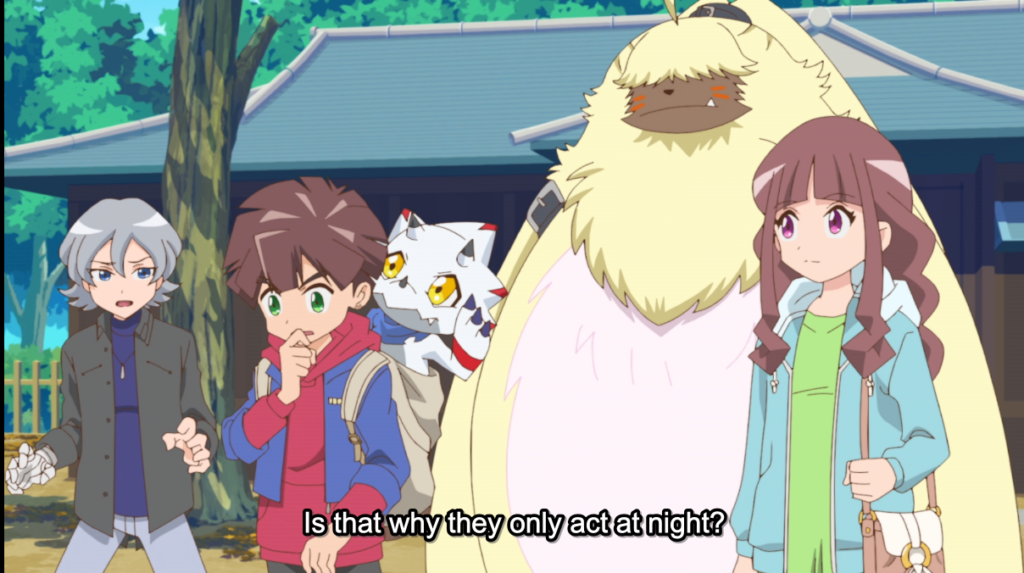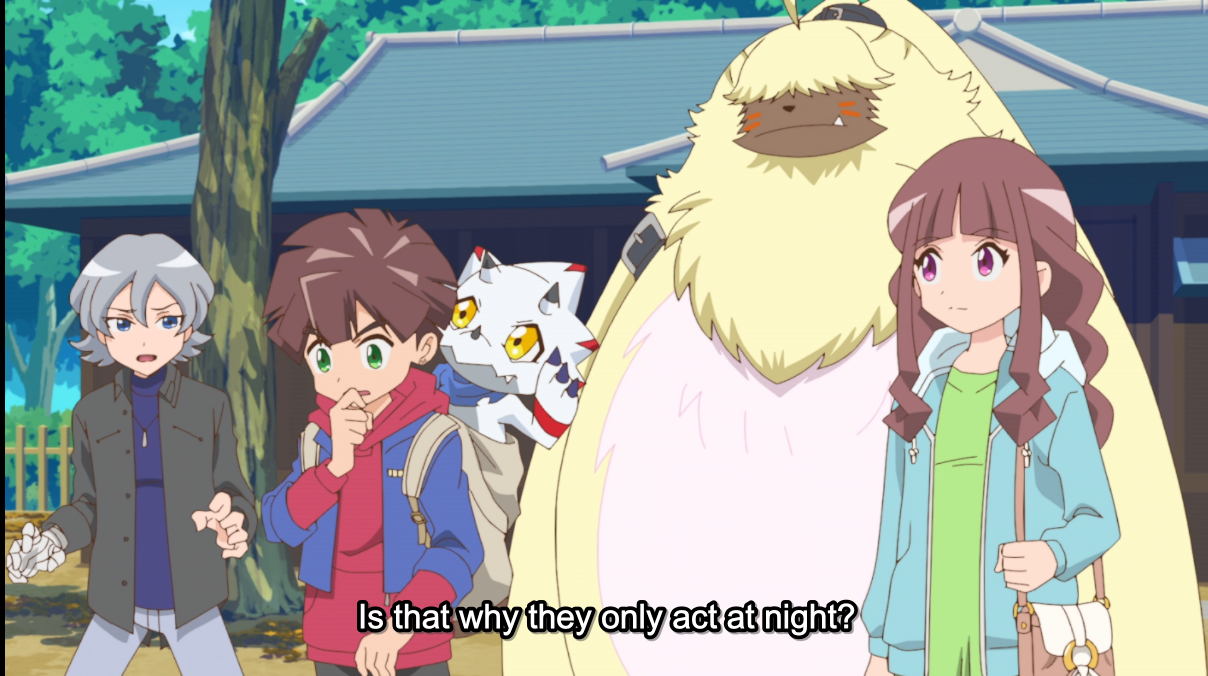Anime Review: Digimon Ghost Game
In the not-too-distant future, advances in hologram technology have made holograms ubiquitous in advertising, robotics, public services and other aspects of life in Japan. Some, it would seem, are even artificially intelligent. But there’s also been a spike in weird, seemingly paranormal activity, often involving creatures that appear to be holograms, referred to as “Hologram Ghosts.”

This installment of the long-running Digimon (for “digital monsters”) franchise takes place in an alternate universe from the others, where none of the previous series’ events happened. Nor were there any Digimon games or anime in this timeline. Instead, the appearance of Digimon in the human world is a recent phenomenon which is happening for reasons even most of the Digimon involved don’t understand.
Some of the visiting Digimon are friendly and usually peaceful, but don’t understand how humans and their society work. Others are selfish and don’t care what damage they do in order to reach their personal goals. And some are, let’s be honest, evil. All of these situations must be dealt with by a team of middle school children and their Digimon partners.
The leader is Hiro Amanokawa, an earnest boy whose father Hokuto went missing some months ago when an attempt to contact the Digital Realm went awry. His father sends a “digivice” that allows Hiro to “synch” with a Digimon, along with Gammamon, a baby triceratops-looking creature with the personality of a preschooler, and instructions for him to be Hiro’s little brother. (Hokuto is bad at communication.) Something of a pacifist, Hiro tries to talk enemies down whenever possible and will often give second or third chances to opponents to stand down and avoid violence.
Ruli Tsukiyono is a talented and pretty girl who runs the “Lilurun” social media site for reports of weird, possibly supernatural events. She’s good at almost everything she tries, most often classical piano, but has a habit of dropping hobbies as fast as she picks them up, and is looking for something that truly satisfies her. Her partner is the rabbit-like Angoramon, who admires her music and is himself given to improvisational haiku. Ruli has a habit of heading directly for danger, which often gets her and the others in trouble. She also has the most guilt about keeping her friends in the dark about the truth of the Digimon situation.
Kiyoshiro Higashimitarai is the boys’ dorm leader at Hiro’s school. He’s a genius who already graduated from college in America, but decided to come back to Japan to try the “ordinary school life” depicted in his favorite anime shows. (Mind, his absolute favorite is about an elf wizard-detective, so he may have some odd ideas about Japanese school life.) Kiyo’s actually a superstitious coward, and before Jellymon finally admitted she was real, thought she was a poltergeist out to get him. Jellymon is an electric jellyfish Digimon who has a bit of a crush on Kiyo, calling him “Darling” ala Lum of Urusei Yatsura, but also is a prankster who enjoys making money through shady tactics, ala Nabiki of Ranma 1/2. Kiyo’s computer whiz abilities often come in handy, but he’s just as likely to be humiliated or transformed by the monster of the week.
Unlike previous installments in the Digimon franchise, which tended to have strong through-line plots interrupted by episodic detours, Ghost Game is much more episodic with only an occasional drip of hints that there even is an overall arc. This became a bit of an issue in the last few episodes where that arc finally kicked in, and the last episode has to have a massive infodump to explain what the plot was supposed to be.
The children’s horror aspect is helped along by narrator Naoto Takenaka, the “Ghost Navigator.” His next episode preview voiceovers really sold how scary some of the premises for the stories were. When production woes forced Toei to do a clip show episode, they filmed live-action segments with Takenaka as a full-blown horror host.
One of the features of the Digimon franchise is “digivolving”, where the monsters temporarily take on more powerful/advanced forms to deal with tougher foes (complete with stock footage.) This remains, though there’s a slight twist. One of Gammamon’s forms is Gulusgammamon, a “dark” transformation that is cruel and far more willing to straight up kill opponents. Usually dark versions of the hero’s partner are mistakes caused by the hero trying to force a transformation before the Digimon partner is ready, or the result of some form of contamination, and are largely one-offs. Gulusgammamon is a legitimate future path for Gammamon, it seems, and implies that Hiro will at some point have to choose to bring him about willingly.
Notably, it’s shown in a couple of episodes that non-Digimon supernatural things are “real,” though it’s never the center of a story or elucidated upon. It’s left a genuine mystery.
As a children’s show, the kids almost never turn to adults, such as the police, to handle matters. They’re the only ones with Digimon partners who can deal with hostile Digimon. and the police are pretty much useless. (In one episode, a police officer is vulnerable to the monster of the week because he’s too enamored of the surveillance state.) Hokuto, the one adult who is familiar with Digimon and might be of some help, is off-world for most of the series and may actually be making things worse.
Content notes: Lots of monster fights, sometimes ending in a Digimon’s “death.” Quite a bit of body horror, and in a few cases, humans die. On-screen suicide. Peril to children. Several Digimon designs are “hot woman with monster bits” which results in some weirdly horny episodes. (What the Doctor Who writers used to call “for the dads.”)
Overall: Switching from a more standard “action” format to a “spooky urban legends” feel helps set Ghost Game apart from its Digimon brethren. Many episodes were quite good (holy crap, the Dagomon episode!) and I enjoyed the characters. But in the end, the slow drip of plot arc hurt the show, making the ending feel rushed and cramped. It’s still well worth watching for most of its run if you’re a fan of either the franchise, or children’s horror.

